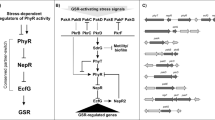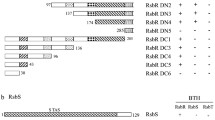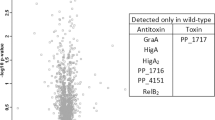Abstract
Although it is well recognized that bacteria respond to environmental stress through global networks, the mechanism by which stress is relayed to the interior of the cell is poorly understood. Here we show that enigmatic toxin-antitoxin systems are vital in mediating the environmental stress response. Specifically, the antitoxin MqsA represses rpoS, which encodes the master regulator of stress. Repression of rpoS by MqsA reduces the concentration of the internal messenger 3,5-cyclic diguanylic acid, leading to increased motility and decreased biofilm formation. Furthermore, the repression of rpoS by MqsA decreases oxidative stress resistance via catalase activity. Upon oxidative stress, MqsA is rapidly degraded by Lon protease, resulting in induction of rpoS. Hence, we show that external stress alters gene regulation controlled by toxin-antitoxin systems, such that the degradation of antitoxins during stress leads to a switch from the planktonic state (high motility) to the biofilm state (low motility).
This is a preview of subscription content, access via your institution
Access options
Subscribe to this journal
Receive 12 print issues and online access
$259.00 per year
only $21.58 per issue
Buy this article
- Purchase on Springer Link
- Instant access to full article PDF
Prices may be subject to local taxes which are calculated during checkout






Similar content being viewed by others
References
Gerdes, K., Christensen, S.K. & Løbner-Olesen, A. Prokaryotic toxin-antitoxin stress response loci. Nat. Rev. Microbiol. 3, 371–382 (2005).
Tsilibaris, V., Maenhaut-Michel, G., Mine, N. & Van Melderen, L. What is the benefit to Escherichia coli of having multiple toxin-antitoxin systems in its genome? J. Bacteriol. 189, 6101–6108 (2007).
Magnuson, R.D. Hypothetical functions of toxin-antitoxin systems. J. Bacteriol. 189, 6089–6092 (2007).
Shah, D. et al. Persisters: A distinct physiological state of E. coli. BMC Microbiol. 6, 53 (2006).
Pecota, D.C. & Wood, T.K. Exclusion of T4 phage by the hok/sok killer locus from plasmid R1. J. Bacteriol. 178, 2044–2050 (1996).
Kim, Y., Wang, X., Ma, Q., Zhang, X.-S. & Wood, T.K. Toxin-antitoxin systems in Escherichia coli influence biofilm formation through YjgK (TabA) and fimbriae. J. Bacteriol. 191, 1258–1267 (2009).
Yamaguchi, Y., Park, J.-H. & Inouye, M. MqsR, a crucial regulator for quorum sensing and biofilm formation, is a GCU-specific mRNA interferase in Escherichia coli. J. Biol. Chem. 284, 28746–28753 (2009).
Brown, B.L. et al. Three dimensional structure of the MqsR:MqsA complex: A novel TA pair comprised of a toxin homologous to RelE and an antitoxin with unique properties. PLoS Pathog. 5, e1000706 (2009).
Aizenman, E., Engelberg-Kulka, H. & Glaser, G. An Escherichia coli chromosomal “addiction module” regulated by 3′,5′-bispyrophosphate: A model for programmed bacterial cell death. Proc. Natl. Acad. Sci. USA 93, 6059–6063 (1996).
Gotfredsen, M. & Gerdes, K. The Escherichia coli relBE genes belong to a new toxin-antitoxin gene family. Mol. Microbiol. 29, 1065–1076 (1998).
Masuda, Y., Miyakawa, K., Nishimura, Y. & Ohtsubo, E. chpA and chpB, Escherichia coli chromosomal homologs of the pem locus responsible for stable maintenance of plasmid R100. J. Bacteriol. 175, 6850–6856 (1993).
Cherny, I. & Gazit, E. The YefM antitoxin defines a family of natively unfolded proteins: Implications as a novel antibacterial target. J. Biol. Chem. 279, 8252–8261 (2004).
Motiejūnaite, R., Armalytė, J., Markuckas, A. & Sužiedėlienė, E. Escherichia coli dinJ-yafQ genes act as a toxin-antitoxin module. FEMS Microbiol. Lett. 268, 112–119 (2007).
Schmidt, O. et al. prlF and yhaV encode a new toxin-antitoxin system in Escherichia coli. J. Mol. Biol. 372, 894–905 (2007).
González Barrios, A.F. et al. Autoinducer 2 controls biofilm formation in Escherichia coli through a novel motility quorum-sensing regulator (MqsR, B3022). J. Bacteriol. 188, 305–316 (2006).
Ren, D., Bedzyk, L.A., Thomas, S.M., Ye, R.W. & Wood, T.K. Gene expression in Escherichia coli biofilms. Appl. Microbiol. Biotechnol. 64, 515–524 (2004).
Kim, Y. & Wood, T.K. Toxins Hha and CspD and small RNA regulator Hfq are involved in persister cell formation through MqsR in Escherichia coli. Biochem. Biophys. Res. Commun. 391, 209–213 (2010).
Kim, Y. et al. Escherichia coli toxin/antitoxin pair MqsR/MqsA regulate toxin CspD. Environ. Microbiol. 12, 1105–1121 (2010).
Pesavento, C. et al. Inverse regulatory coordination of motility and curli-mediated adhesion in Escherichia coli. Genes Dev. 22, 2434–2446 (2008).
Hengge, R. The two-component network and the general stress sigma factor RpoS (σS) in Escherichia coli. in Bacterial Signal Transduction: Networks and Drug Targets 40–53 (Springer, New York, 2008).
Boehm, A. et al. Second messenger-mediated adjustment of bacterial swimming velocity. Cell 141, 107–116 (2010).
Pesavento, C. & Hengge, R. Bacterial nucleotide-based second messengers. Curr. Opin. Microbiol. 12, 170–176 (2009).
Sammartano, L.J., Tuveson, R.W. & Davenport, R. Control of sensitivity to inactivation by H2O2 and broad-spectrum near-UV radiation by the Escherichia coli katF locus. J. Bacteriol. 168, 13–21 (1986).
Storz, G. & Imlay, J.A. Oxidative stress. Curr. Opin. Microbiol. 2, 188–194 (1999).
Lacour, S. & Landini, P. σS-dependent gene expression at the onset of stationary phase in Escherichia coli: Function of σS-dependent genes and identification of their promoter sequences. J. Bacteriol. 186, 7186–7195 (2004).
Baba, T. et al. Construction of Escherichia coli K-12 in-frame, single-gene knockout mutants: the Keio collection. Mol. Syst. Biol. 2, 2006.0008 (2006).
Landini, P. Cross-talk mechanisms in biofilm formation and responses to environmental and physiological stress in Escherichia coli. Res. Microbiol. 160, 259–266 (2009).
Brown, B.L., Wood, T.K., Peti, W. & Page, R. Structure of the Escherichia coli antitoxin MqsA (YgiT/b3021) bound to its gene promoter reveals extensive domain rearrangements and the specificity of transcriptional regulation. J. Biol. Chem. 286, 2285–2296 (2011).
Alexeyev, M.F. The pKNOCK series of broad-host-range mobilizable suicide vectors for gene knockout and targeted DNA insertion into the chromosome of gram-negative bacteria. Biotechniques 26, 824–828 (1999).
Ma, Q. & Wood, T.K. OmpA influences Escherichia coli biofilm formation by repressing cellulose production through the CpxAR two-component system. Environ. Microbiol. 11, 2735–2746 (2009).
Donegan, N.P., Thompson, E.T., Fu, Z. & Cheung, A.L. Proteolytic regulation of toxin-antitoxin systems by ClpPC in Staphylococcus aureus. J. Bacteriol. 192, 1416–1422 (2010).
Altuvia, S., Weinstein-Fischer, D., Zhang, A., Postow, L. & Storz, G. A small, stable RNA induced by oxidative stress: Role as a pleiotropic regulator and antimutator. Cell 90, 43–53 (1997).
Van Melderen, L., Bernard, P. & Couturier, M. Lon-dependent proteolysis of CcdA is the key control for activation of CcdB in plasmid-free segregant bacteria. Mol. Microbiol. 11, 1151–1157 (1994).
Christensen, S.K., Mikkelsen, M., Pedersen, K. & Gerdes, K. RelE, a global inhibitor of translation, is activated during nutritional stress. Proc. Natl. Acad. Sci. USA 98, 14328–14333 (2001).
Kasari, V., Kurg, K., Margus, T., Tenson, T. & Kaldalu, N. The Escherichia coli mqsR and ygiT genes encode a new toxin-antitoxin pair. J. Bacteriol. 192, 2908–2919 (2010).
Kolodkin-Gal, I., Verdiger, R., Shlosberg-Fedida, A. & Engelberg-Kulka, H. A differential effect of E. coli toxin-antitoxin systems on cell death in liquid media and biofilm formation. PLoS ONE 4, e6785 (2009).
Zhang, X.-S., García-Contreras, R. & Wood, T.K. YcfR (BhsA) influences Escherichia coli biofilm formation through stress response and surface hydrophobicity. J. Bacteriol. 189, 3051–3062 (2007).
Ito, A., May, T., Kawata, K. & Okabe, S. Significance of rpoS during maturation of Escherichia coli biofilms. Biotechnol. Bioeng. 99, 1462–1471 (2008).
Domka, J., Lee, J., Bansal, T. & Wood, T.K. Temporal gene-expression in Escherichia coli K-12 biofilms. Environ. Microbiol. 9, 332–346 (2007).
Ito, A., Taniuchi, A., May, T., Kawata, K. & Okabe, S. Increased antibiotic resistance of Escherichia coli in mature biofilms. Appl. Environ. Microbiol. 75, 4093–4100 (2009).
Ito, A., May, T., Taniuchi, A., Kawata, K. & Okabe, S. Localized expression profiles of rpoS in Escherichia coli biofilms. Biotechnol. Bioeng. 103, 975–983 (2009).
Zheng, M. et al. DNA microarray-mediated transcriptional profiling of the Escherichia coli response to hydrogen peroxide. J. Bacteriol. 183, 4562–4570 (2001).
Zhang, A. et al. The OxyS regulatory RNA represses rpoS translation and binds the Hfq (HF-I) protein. EMBO J. 17, 6061–6068 (1998).
Gruber, T.M. & Gross, C.A. Multiple sigma subunits and the partitioning of bacterial transcription space. Annu. Rev. Microbiol. 57, 441–466 (2003).
Pennington, J.M. & Rosenberg, S.M. Spontaneous DNA breakage in single living Escherichia coli cells. Nat. Genet. 39, 797–802 (2007).
Dörr, T., Lewis, K. & Vulić, M. SOS response induces persistence to fluoroquinolones in Escherichia coli. PLoS Genet. 5, e1000760 (2009).
Datsenko, K.A. & Wanner, B.L. One-step inactivation of chromosomal genes in Escherichia coli K-12 using PCR products. Proc. Natl. Acad. Sci. USA 97, 6640–6645 (2000).
Ueda, A. & Wood, T.K. Connecting quorum sensing, c-di-GMP, Pel polysaccharide, and biofilm formation in Pseudomonas aeruginosa through tyrosine phosphatase TpbA (PA3885). PLoS Pathog. 5, e1000483 (2009).
Macvanin, M. & Hughes, D. Assays of sensitivity of antibiotic-resistant bacteria to hydrogen peroxide and measurement of catalase activity. in Antibiotic Resistance Protocols: Second Edition, Methods in Molecular Biology Vol. 642 (Gillespie, S.H. & McHugh, T.D., eds), 95–103 (Humana Press, 2010).
Rice, P., Longden, I. & Bleasby, A. EMBOSS: The European Molecular Biology Open Software Suite (2000). Trends Genet. 16, 276–277 (2000).
Acknowledgements
This work was supported by grants from the US National Institutes of Health to T.K.W. and W.P. and an F31 fellowship to B.L.B. and by a US National Science Foundation CAREER award to R.P. We are grateful for the Keio and ASKA strains provided by the Genome Analysis Project in Japan.
Author information
Authors and Affiliations
Contributions
T.K.W. conceived the project, T.K.W., X.W., R.P., W.P. and M.J.B. designed the experiments. X.W., S.H.H., Q.M., B.L.B., M.P. and Y.K. performed the experiments. M.J.B. and A.M.T. performed the bioinformatics. All authors discussed the results and commented on the manuscript.
Corresponding author
Ethics declarations
Competing interests
The authors declare no competing financial interests.
Supplementary information
Supplementary Text and Figures
Supplementary Methods, Supplementary Tables 1–4 and Supplementary Figures 1–5 (PDF 1303 kb)
Rights and permissions
About this article
Cite this article
Wang, X., Kim, Y., Hong, S. et al. Antitoxin MqsA helps mediate the bacterial general stress response. Nat Chem Biol 7, 359–366 (2011). https://doi.org/10.1038/nchembio.560
Received:
Accepted:
Published:
Issue Date:
DOI: https://doi.org/10.1038/nchembio.560
This article is cited by
-
Comparative genomics of seven genomes of genus Idiomarina reveals important halo adaptations and genes for stress response
3 Biotech (2024)
-
Biology and evolution of bacterial toxin–antitoxin systems
Nature Reviews Microbiology (2022)
-
Increased whiB7 expression and antibiotic resistance in Mycobacterium chelonae carrying two prophages
BMC Microbiology (2021)
-
Impacts of type II toxin-antitoxin systems on cell physiology and environmental behavior in acetic acid bacteria
Applied Microbiology and Biotechnology (2021)
-
Rapid growth inhibitory activity of a YafQ-family endonuclease toxin of the Helicobacter pylori tfs4 integrative and conjugative element
Scientific Reports (2020)



